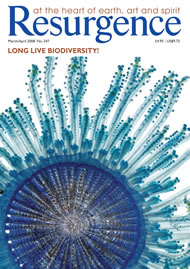THIS BOOK IS based on a simple but effective principle: contrasting pictures of the same spot as it was at some past time, as far back as 1857 or as recently as a year or two ago, and that same spot as it has since become. Perhaps the strongest group of pictures are those with which the book leads: of the icy realm. Any climate change denier would be hard-put to explain away this catalogue of dwindling glaciers from the Alps to the Andes, the collapsing ice-shelves of Antarctica, and the melting Arctic
sea-ice.
In Southeast Asia we see how elegant, sedate Singapore and Hong Kong vanish to be replaced by a landscape of thrusting glass towers. In Tokyo and São Paulo, historic townscapes disappear beneath concrete and illuminated hoardings. The process is reversed in New York with the disappearance of the iconic twin towers of the World Trade Center.
A more creative urban re-
engineering is shown in Seoul, whose main river, sewerised and built over with surface roads and a four-lane viaduct during the 1970s, is restored into a green-blue river corridor in a welcome reminder that change can sometimes be for the better. And the resurrections of Hiroshima, Nagasaki, Leningrad, Caen, the City of London and Dresden’s Frauenkirche after the Second World War are surely matters for celebration.
Yet cities are expanding everywhere, into farmland, forests and desert. Mostly the aerial photographs show green giving way to browns and dull greys, from Sydney to Beijing to South America – except in Las Vegas where the brown desert is replaced by the green of a million sprinkler systems fed by fossil water. A similar pattern emerges in the Amazon, where colonisation in Rondônia and Bolivia breaks up the billiard-table-green immensity of the forest into a patchwork agricultural landscape of brown fields and herringbone road systems.
Some changes lie entirely beyond human control, like the explosion of Mount St. Helens in 1973, or the volcanic ash fields that have overtaken southern Montserrat in the Caribbean since the Soufrière volcano came to life, or again the collapse of the historic Iranian city of Bam, built entirely of adobe, in December 2003, with the death of 23,000 people – the same number that died when Yungay in the Peruvian Andes was destroyed in 1970 by a killer slide of mud, ice and water from nearby Mount Huascarán which buried the entire town under metres of debris. And a year after the obliteration of Bam, the Boxing Day tsunami wreaked its own brand of death and destruction, turning the green, fertile and densely settled countryside of Aceh into a black-brown mudscape.
No doubt about it: this is a picture book, and it will look good on the coffee table. But pictures demand explanations and commentary, and this is provided by New Scientist’s Fred Pearce, whose descriptions, each an economical 100 words or so in length, hit just the right neutral and informative note that lets the pictures tell their own story without inflicting superfluous value judgements. And who would disagree with his final thought? “Nature is not as fragile as we think. She is resilient. In time, she may recover from the worst we can throw at her. It is we, ultimately, who are the fragile ones. Look at these pictures and fear not so much for Nature: fear for us.”
My own final thoughts are to commend the diligence and frequently the inspiration of the picture researchers, who have tried hard to match the before and after shots to ensure the closest possible correspondence of locations, camera angles and lenses. There is just one thing that bothers me about this book: although its purpose must be to raise environmental awareness, there is not a word about the paper it is printed on, and thus no guarantee that it does not come from a clear-felled forest of the kind it pictures in the Sierra Nevada of a nameless western state of the USA. If Bloomsbury can source FSC-certified paper for its vast Harry Potter print runs, Mitchell Beazley can do so too. The fear must otherwise be that the book’s production has only added to the problems that it so graphically illustrates.






